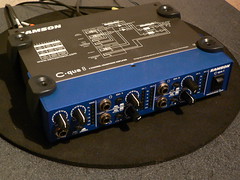B. Thomas Cooper
Editor
Once upon a time, not too long ago, mind you, building a respectable home studio' required a rather substantial investment in time and money.
Back in the day, so to speak, we were still recording in analog, and a decent eight track tape machine cost a few thousand dollars at a minimum. Then there was the console (desk, mixer, etc.) consisting of perhaps twenty-four channels, which cost another couple grand. Of course, no home studio was complete without at least a couple racks of outboard gear. We had doozles and raddoids and multiple compressors and delay devices, each guaranteed to muddy up the mix. All of this was then routed together with cables and wires and strewn about in disarray. Getting it all to sound good was never an easy task.

Nick Gill in Studio A
These days things are little different. The advent of digital technology has changed much about how we record sound and music. Oh, we still have our share of doozles and raddoids, but now they are called add-ons' and they are included with the recording software. Most of the clumsy cables have long been chucked into the trash. We like to run a clean shop
Over the years, I have designed and overseen the construction of countless studios. It's one of those things I do. From coast to coast, from sea to shining sea. Big rooms, little rooms they are all the same. The trick is to create an environment conducive to the recording process. The best advice I can give is learn to keep your sound pressure levels under control. Deafening volume levels are not a good idea in small enclosures. When in doubt turn it down.
There are numerous companies offering digital recording software at reasonable prices. The choice is yours. For starters, I recommend Sonar for the initial recording process and Sound-Forge for the mastering process. It's really not as hard as it sounds, and these days even a caveman like myself can afford it.
In any studio, a bad headphone mix is as inexcusable as it is predictable. How in the name of Marilyn Manson can anyone expect to lay down strong basic tracks if you can’t hear what the other musicians are doing? The same holds true for the overdub process. A musician is only as good as his (or her) ears. If the sound in your cans doesn’t rock, your not apt to perform at your best.
For this, I recommend Samson 4 C-que 8 headphone amplifier, ideal for small studio applications, addressing many of the problems associated with typical inferior headphone mixes.
With a retail price of around $149.00, the Samson 4 C-que 8 is a safe and affordable solution. It fits nicely on the desk or console, and my unit has yet to throw me any curves. This is a quality device with no apparent drawbacks. I would recommend the Samson 4 C-que 8 to anyone serious about their workstation or studio headphone mixes.
Obviously, you will also need reliable headphones. Again, you are only as good as your ears can hear. I suggest a couple pairs of Sony V600’s These are a fine offering by Sony, a sturdy set of headphones, with firm, comfortable ear pieces and a warm, desirable frequency response. In simple words… a good investment for anyone looking for a reliable set of headphones.
You will also need an array of dependable microphones, but this subject is covered in great depth in a separate article. Also available at Helium. If you are new to recording, take a few minutes and read a few articles on the subject. You just might learn something!










